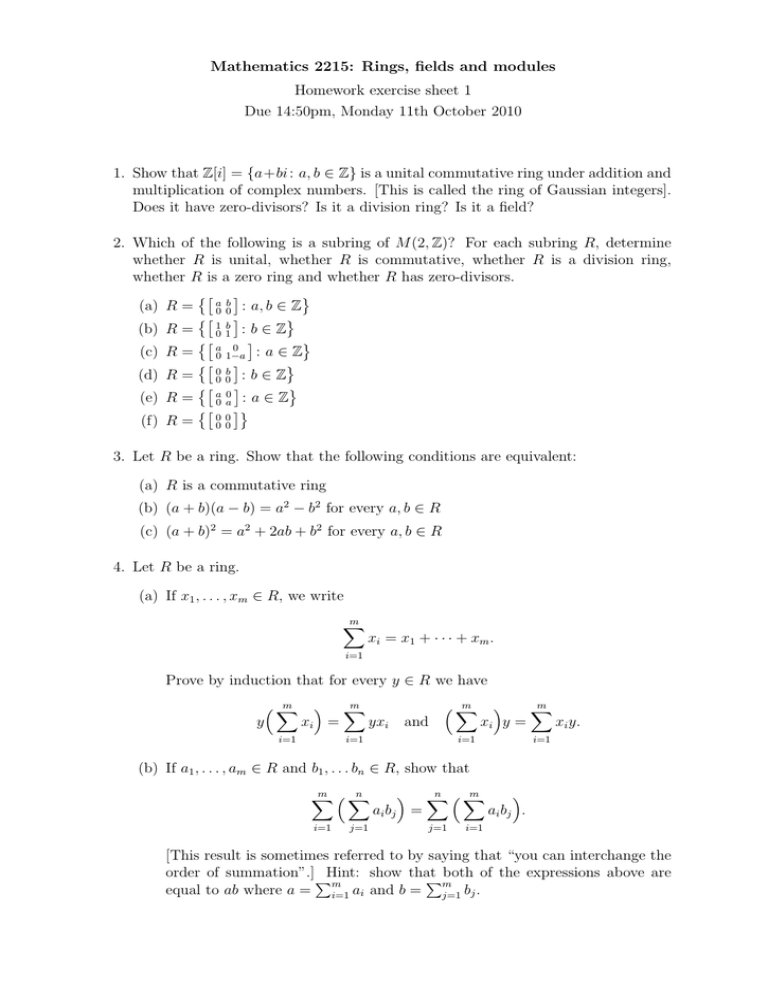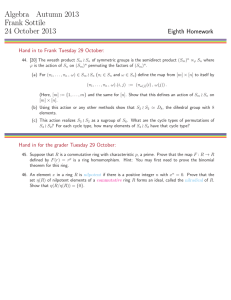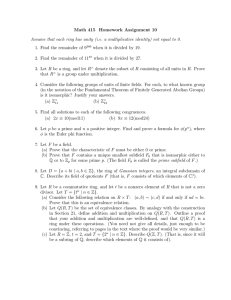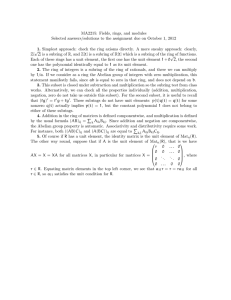Mathematics 2215: Rings, fields and modules Homework exercise sheet 1
advertisement

Mathematics 2215: Rings, fields and modules
Homework exercise sheet 1
Due 14:50pm, Monday 11th October 2010
1. Show that Z[i] = {a+bi : a, b ∈ Z} is a unital commutative ring under addition and
multiplication of complex numbers. [This is called the ring of Gaussian integers].
Does it have zero-divisors? Is it a division ring? Is it a field?
2. Which of the following is a subring of M (2, Z)? For each subring R, determine
whether R is unital, whether R is commutative, whether R is a division ring,
whether R is a zero ring and whether R has zero-divisors.
(a) R = a0 0b : a, b ∈ Z
(b) R = 10 1b : b ∈ Z
0 (c) R = a0 1−a
:a∈Z
(d) R = 00 0b : b ∈ Z
(e) R = a0 a0 : a ∈ Z
(f) R = 00 00
3. Let R be a ring. Show that the following conditions are equivalent:
(a) R is a commutative ring
(b) (a + b)(a − b) = a2 − b2 for every a, b ∈ R
(c) (a + b)2 = a2 + 2ab + b2 for every a, b ∈ R
4. Let R be a ring.
(a) If x1 , . . . , xm ∈ R, we write
m
X
xi = x1 + · · · + xm .
i=1
Prove by induction that for every y ∈ R we have
y
m
X
m
X
xi =
yxi
i=1
and
m
X
i=1
m
X
xi y =
xi y.
i=1
i=1
(b) If a1 , . . . , am ∈ R and b1 , . . . bn ∈ R, show that
m X
n
X
i=1
j=1
ai b j =
n X
m
X
j=1
ai b j .
i=1
[This result is sometimes referred to by saying that “you can interchange the
order of summation”.] PHint: show that
both of the expressions above are
Pm
m
equal to ab where a = i=1 ai and b = j=1 bj .
5. Let n ∈ N, let R be a ring and let M (n, R) be the set of n × n matrices with entries
in R.
We define two operations, matrix addition and matrix multiplication, on M (n, R)
as follows. For A, B ∈ M (n, R), if the i, j entry of A is aij and the i, j entry of B
is bij , we define
A+B =C
where the i, j entry of C is cij = aij + bij , and
n
X
A · B = D where the i, j entry of D is dij =
aik bkj .
k=1
(a) Explain how the definition of A + B and A · B depend on the definition of
addition and multiplication in the ring R.
(b) Prove that M (n, R) with matrix addition and matrix multiplication is a ring.
(c) Prove that if n > 1 then the ring M (n, R) is commutative if and only if ab = 0
for all a, b ∈ R.
Hint: for “⇒”, first think about n = 2 and the matrices a0 00 and 00 0b .
(d) If R is a unital ring, prove that M (n, R) is also a unital ring.
(e) Prove that if n > 1 then M (n, R) is not a division ring.
6. Consider the following four matrices in M (2, C):
1 0
i 0
0 1
1=
, i=
, j=
0 1
0 −i
−1 0
0 i
and k =
.
i 0
Let
H = {a1 + bi + cj + dk : a, b, c, d ∈ R}.
(a) It’s not hard to see that i2 = j2 = k2 = ijk = −1. Use these equations to
calculate ij, jk, ki, ji, kj, and ik.
(b) Show that H is a unital subring of M (2, C).
(c) Prove that H is not a commutative ring.
(d) Prove that H is a division ring. Hint: for z = a1 + bi + cj + dk, consider
z = a1 − bi − cj − dk and show that zz = (a2 + b2 + c2 + d2 )1.
(e) Show that the set
Z[i, j, k] = {a1 + bi + cj + dk : a, b, c, d ∈ Z}
is a subring of H which is unital, non-commutative and has no zero-divisors,
but is not a division ring.
2







